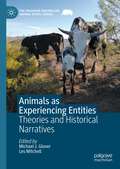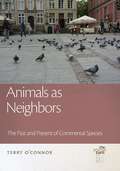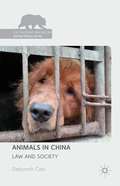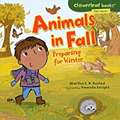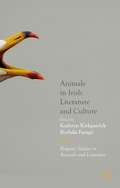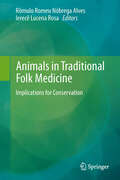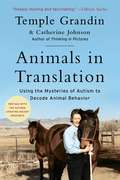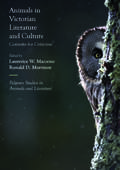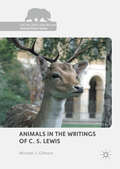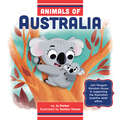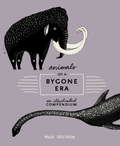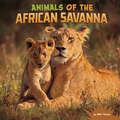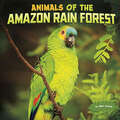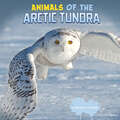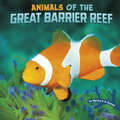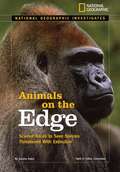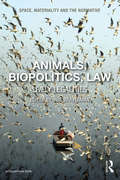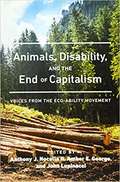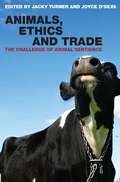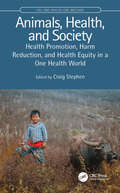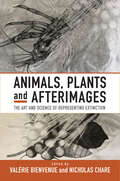- Table View
- List View
Animals as Experiencing Entities: Theories and Historical Narratives (The Palgrave Macmillan Animal Ethics Series)
by Les Mitchell Michael J. GloverThis volume explores the experiences of those with little or no power—usually, although not exclusively, animals. The theme of animals as experiencing entities is what links the chapters and characterises the volume. Broadly each author in this volume contributes in one of two ways. The first group, in Section 1, theoretically engages animal subjectivity, animal experiences, and ways in which these are to some extent accessible and knowable to humans. The second group of authors, in Section 2, offer narrative accounts about specific animals or groups of animals and explore to some extent their subjective historical experiences. In summary, the first section diversely theorises about animal experiences, while the second section’s authors assume animals’ subjective experiences and construct narratives that take into account how animals might have subjectively experienced historical phenomena.
Animals as Neighbors: The Past and Present of Commensal Animals (The Animal Turn)
by Terry O'ConnorIn this fascinating book, Terry O’Connor explores a distinction that is deeply ingrained in much of the language that we use in zoology, human-animal studies, and archaeology—the difference between wild and domestic. For thousands of years, humans have categorized animals in simple terms, often according to the degree of control that we have over them, and have tended to see the long story of human-animal relations as one of increasing control and management for human benefit. And yet, around the world, species have adapted to our homes, our towns, and our artificial landscapes, finding ways to gain benefit from our activities and so becoming an important part of our everyday lives. These commensal animals remind us that other species are not passive elements in the world around us but intelligent and adaptable creatures. Animals as Neighbors shows how a blend of adaptation and opportunism has enabled many species to benefit from our often destructive footprint on the world. O’Connor investigates the history of this relationship, working back through archaeological records. By requiring us to take a multifaceted view of human-animal relations, commensal animals encourage a more nuanced understanding of those relations, both today and throughout the prehistory of our species.
Animals in Art
by Jessica RawsonAnimals have been the subject of art from the time that man started to draw, engrave and carve. They have been and are almost as important to men as man himself. In many societies and at many periods animals have been the most prominent subject of art. But this art shows much more varied attitudes to animals than those we today at first expect. In modern urbanised society we look on most animals from a distance. This distance is not bridged by the great extent of our modern scientific knowledge.
Animals in China: Law And Society (The Palgrave Macmillan Animal Ethics Series)
by Deborah CaoJust as China is called the world factory for manufactured goods, it is also a world factory for manufactured animal cruelty in a new phenomenon of globalized animal cruelty. Animals in China examines animal protection in China in its legal, social and cultural contexts.
Animals in Fall Preparing for Winter: Preparing For Winter (Cloverleaf Books)
by Martha E. H. RustadA boy learns how animals prepare for winter.
Animals in Irish Literature and Culture
by Kathryn Kirkpatrick Borbála FaragóAnimals in Irish Literature and Culture spans the early modern period to the present, and includes essays exploring some of Ireland's better known animals—birds, horses, pigs, cows, and dogs—as well as its less considered animals—hares, foxes, eels, and insects. The collection also unsettles the boundaries and definitions of 'nation' by exploring colonial, post-colonial, and globalized manifestations of Ireland as country and state as well as the human animal and non-humananimal migrations that challenge a variety of literal and cultural borders. In essays addressing a range of Irish cultural production, contributors consider the impacts of conceptual categories of nature, animality, and humanness on actual human and animal lives. Emerging in the era of the sixth mass extinction, brought on by human-induced climate change and habitat destruction, this volume aims to make a contribution to eco-critical thought and practice in Irish Studies and beyond.
Animals in Traditional Folk Medicine: Implications for Conservation
by Ierecê Lucena Rosa Rômulo Romeu AlvesPeople have relied on medicinal products derived from natural sources for millennia, and animals have long been an important part of that repertoire; nearly all cultures, from ancient times to the present, have used animals as a source of medicine. Ingredients derived from wild animals are not only widely used in traditional remedies, but are also increasingly valued as raw materials in the preparation of modern medicines. Regrettably, the unsustainable use of plants and animals in traditional medicine is recognized as a threat to wildlife conservation, as a result of which discussions concerning the links between traditional medicine and biodiversity are becoming increasingly imperative, particularly in view of the fact that folk medicine is the primary source of health care for 80% of the world's population. This book discusses the role of animals in traditional folk medicine and its meaning for wildlife conservation. We hope to further stimulate further discussions about the use of biodiversity and its implications for wildlife conservation strategies.
Animals in Translation: Using the Mysteries of Autism to Decode Animal Behavior (Read-On)
by Catherine Johnson Temple GrandinWith unique personal insight, experience, and hard science, Animals in Translation is the definitive, groundbreaking work on animal behavior and psychology.Temple Grandin&’s professional training as an animal scientist and her history as a person with autism have given her a perspective like that of no other expert in the field of animal science. Grandin and coauthor Catherine Johnson present their powerful theory that autistic people can often think the way animals think—putting autistic people in the perfect position to translate &“animal talk.&” Exploring animal pain, fear, aggression, love, friendship, communication, learning, and even animal genius, Grandin is a faithful guide into their world. Animals in Translation reveals that animals are much smarter than anyone ever imagined, and Grandin, standing at the intersection of autism and animals, offers unparalleled observations and extraordinary ideas about both.
Animals in Victorian Literature and Culture: Contexts for Criticism (Palgrave Studies in Animals and Literature)
by Laurence W. Mazzeno Ronald D. MorrisonThis collection includes twelve provocative essays from a diverse group of international scholars, who utilize a range of interdisciplinary approaches to analyze "real" and "representational" animals that stand out as culturally significant to Victorian literature and culture. Essays focus on a wide range of canonical and non-canonical Victorian writers, including Charles Dickens, Anthony Trollope, Anna Sewell, Emily Bronte, James Thomson, Christina Rossetti, and Richard Marsh, and they focus on a diverse array of forms: fiction, poetry, journalism, and letters. These essays consider a wide range of cultural attitudes and literary treatments of animals in the Victorian Age, including the development of the animal protection movement, the importation of animals from the expanding Empire, the acclimatization of British animals in other countries, and the problems associated with increasing pet ownership. The collection also includes an Introduction co-written by the editors and Suggestions for Further Study, and will prove of interest to scholars and students across the multiple disciplines which comprise Animal Studies.
Animals in Winter
by Henrietta Bancroft Richard G. VangelderWhen winter winds blow, people stay warm inside their homes. But what do animals do? Animals have many methods of coping with winter. Some simply sleep it out: They hibernate. Others make tracks for warmer climes: They migrate. Still other animals don't plan ahead at all and must get through whatever weather comes their way. Young animal lovers will be curious to discover what happens to their favorite creatures in winter. Presch-1
Animals in Winter (Let's-Read-and-Find-Out Science 1 #1)
by Henrietta Bancroft Richard G. Van GelderRead and find out about how animals cope with winter in this colorfully illustrated nonfiction picture book.This is a clear and appealing book for early elementary age kids, both at home and in the classroom. Introduce kids to basic science ideas as part of discussions about the seasons and animals.Have you ever seen a butterfly in the snow? Probably not. Butterflies can't survive cold weather, so when winter comes, many butterflies fly to warmer places. They migrate. Woodchucks don't like cold weather either, but they don't migrate; they hibernate. Woodchucks sleep in their dens all winter long. How do these and other animals handle the cold and snow of winter?Read and find out in the proven winner Animals in Winter!This is a Level 1 Let's-Read-and-Find-Out, which means the book explores introductory concepts perfect for children in the primary grades. The 100+ titles in this leading nonfiction series are:hands-on and visualacclaimed and trustedgreat for classroomsTop 10 reasons to love LRFOs:Entertain and educate at the same timeHave appealing, child-centered topicsDevelopmentally appropriate for emerging readersFocused; answering questions instead of using survey approachEmploy engaging picture book quality illustrationsUse simple charts and graphics to improve visual literacy skillsFeature hands-on activities to engage young scientistsMeet national science education standardsWritten/illustrated by award-winning authors/illustrators & vetted by an expert in the fieldOver 130 titles in print, meeting a wide range of kids' scientific interestsBooks in this series support the Common Core Learning Standards, Next Generation Science Standards, and the Science, Technology, Engineering, and Math (STEM) standards. Let's-Read-and-Find-Out is the winner of the American Association for the Advancement of Science/Subaru Science Books & Films Prize for Outstanding Science Series.
Animals in the Writings of C. S. Lewis (The Palgrave Macmillan Animal Ethics Series)
by Michael J. GilmourThis book examines C. S. Lewis's writings about animals, and the theological bases of his opposition to vivisection and other cruelties. It argues Genesis is central to many of these ethical musings and the book's organization reflects this. It treats in turn Lewis's creative approaches to the Garden of Eden, humanity's "dominion" over the earth, and the loss of paradise with all the catastrophic consequences for animals it presaged. The book closes looking at Lewis's vision of a more inclusive community. Though he left no comprehensive summary of his ideas, the Narnia adventures and science fiction trilogy, scattered poems and his popular theology inspire affection and sympathy for the nonhuman. This study challenges scholars to reassess Lewis as not only a literary critic and children's author but also an animal theologian of consequence, though there is much here for all fans of Mr. Bultitude and Reepicheep to explore.
Animals of Australia
by Jo ParkerExplore the Australian Outback to find koalas, kangaroos, crocodiles, and more!Did you know kangaroos can jump 10 feet high? And they can travel up to speeds of 40 miles per hour!Learn more fun facts about some of Australia's favorite animals! In connection with the publication of Animals of Australia, Penguin Random House will donate a portion of the proceeds to support efforts to provide Australian bushfire relief.
Animals of a Bygone Era: An Illustrated Compendium
by Maja SäfströmA beautifully illustrated collection of fascinating, surprising, and funny facts about extinct animals.In the past, amazing and strange animals roamed the earth, including giant sea scorpions, tiny horses, enormous sloths, and fierce "terror birds." These and many more fantastic extinct animals are illustrated in this whimsical collection by Swedish artist Maja Säfström.
Animals of the African Savanna (Wild Biomes)
by Mari SchuhBiomes are home to unique animals and plants. Introduce beginning readers to the African Savanna biome! Readers will get an up-close look at the characteristics of the land and weather and how zebras, lions, giraffes, and other animals have adapted to life in this amazing biome.
Animals of the Amazon Rain Forest (Wild Biomes)
by Mari SchuhBiomes are home to unique animals and plants. Give beginning readers an introductory look at the Amazon rain forest! Readers will get an up-close look at the characteristics of the land and weather and how monkeys, parrots, anacondas, sloths, and other animals have adapted to life in this amazing biome.
Animals of the Arctic Tundra (Wild Biomes)
by Martha E. RustadBiomes are home to unique animals and plants. Give beginning readers an introductory look at the Arctic tundra! Readers will get an up-close look at the characteristics of the land and weather and how polar bears, Arctic hares, snowy owls, and other animals have adapted to life in this amazing biome.
Animals of the Great Barrier Reef (Wild Biomes)
by Martha E. RustadBiomes are home to unique animals and plants. Introduce beginning readers to the Great Barrier Reef! Readers will get an up-close look at the characteristics of the reef and how corals, fish, anemones, rays, birds, and other animals have adapted to life in and around this amazing biome.
Animals of the Rain Forest (Into Reading, Level Q #9)
by Debbie CroftNIMAC-sourced textbook. A rain forest is a home for many animals. Birds, bats, monkeys, snakes, and more live among the trees in this wet, green place.
Animals on the Edge: Science Races to Save Species Threatened with Extinction
by Sandra PobstThe informed and educational narrative examines numerous threats to animals in the wild, raising awareness of each species, and detailing the extent and urgency of the problem. The book also encourages young animal lovers to take an active role in the preservation of creatures great and small.
Animals, Biopolitics, Law: Lively Legalities
by Irus BravermanTypically, the legal investigation of nonhuman life, and of animal life in particular, is conducted through the discourse of animal rights. Within this discourse, legal rights are extended to certain nonhuman animals through the same liberal framework that has afforded human rights before it. Animals, Biopolitics, Law envisions the possibility of lively legalities that move beyond the humanist perspective. Drawing on an array of expertise—from law, geography, and anthropology, through animal studies and posthumanism, to science and technology studies—this interdisciplinary collection asks what, in legal terms, it means to be human and nonhuman, what it means to govern and to be governed, and what are the ethical and political concerns that emerge in the project of governing not only human but also more-than-human life.
Animals, Disability, and the End of Capitalism: Voices from the Eco-Ability Movement (Radical Animal Studies and Total Liberation #1)
by John Lupinacci Anthony J. Nocella Amber E. George<p>Animals, Disability, and the End of Capitalism is a collection of essays from the leaders in the field of eco-ability. The book is rooted in critical pedagogy, inclusive education, and environmental education. The efforts of diverse disability activists work to weave together the complex diversity and vastly overlooked interconnections among nature, ability, and animals. Eco-ability challenges social constructions, binaries, domination, and normalcy. Contributors challenge the concepts of disability, animal, and nature in relation to human and man. Eco-ability stresses the interdependent relationship among everything and how the effect of one action such as the extinction of a species in Africa can affect the ecosystem in Northern California. Animals, Disability, and the End of Capitalism is timely and offers important critical insight from within the growing movement and the current academic climate for such scholarship. The book also provides insights and examples of radical experiences, pedagogical projects, and perspectives shaped by critical animal studies, critical environmental studies, and critical disability studies. <p>Contributors include Sarah R. Adams, Marissa Anderson, Judy K. C. Bentley, Mary Fantaske, Amber E. George, Ava HaberkornHalm, John Lupinacci, Hannah Monroe, Anthony J. Nocella II, Nicole R. Pallotta, Meneka Repka, and Daniel Salomon.</p>
Animals, Ethics and Trade: The Challenge of Animal Sentience
by Joyce D'Silva Jacky TurnerModern urban life cuts us off from direct connection with the animal world, yet daily the lives of millions of animals are affected by what we consume and wear and what we trade in. The use of animals for food, labour and pleasure pursuits has long been justified with the assumption that unlike humans, animals aren't fully sentient beings. In recent years, however, science has revealed an astonishing array of complex animal behaviour, and scientists and policy makers now accept that the animals we make use of are indeed conscious, with preferences and intentions. The implications for our culture of factory farming, fast food and rainforest liquidation are staggering. In this powerful book, internationally renowned experts on animal behaviour and agriculture such as Jane Goodall, Tim Lang and Vandana Shiva are brought together with ethicists, religious scholars, international industry and regulators for the first time to debate these critical issues and tackle the profound implications of animal sentience. ? The first sections discuss scientific and ethical perspectives on the consciousness, emotions and mental abilities of animals. Later sections address how human activities such as science, law, religion, farming, food production, trade, development and education respect or ignore animals' sentience and welfare, and review the options for changes in our policies, our practices and our thinking. The result is nothing less than a stark and necessary look into the heart of humanity and the ethics that govern our animal powered society.
Animals, Health, and Society: Health Promotion, Harm Reduction, and Health Equity in a One Health World (CRC One Health One Welfare)
by Craig StephenThis timely book reframes the historic narrative of people, animals, and nature as risks to each other, to one where we think about health as a shared capacity. This new narrative promotes the positive contributions made to health across species and generations and addresses growing calls to shift from a reactive to proactive approach in One Health. Editor Craig Stephen takes the reader on a tour of the situations wherein we can all, regardless of our job description, work across species, sectors, and generations to motivate action. Perspectives and methods from a variety of fields and experts are shared and adapted to promote collaborative understanding of and action on determinants of health at the animal-society interface. Case studies demonstrate that the principles and practices presented are feasible, empowering people to make choices that concurrently benefit the health of animals, societies, and ecosystems. The first book to adapt and explain health promotion, harm reduction, and health equity issues in a One Health context, and in terms of animal health, this is necessary reading for students of and practitioners working in planetary health, conservation, ecohealth, public health, health promotion, veterinary medicine, and animal welfare.
Animals, Plants and Afterimages: The Art and Science of Representing Extinction
by Nicholas Chare Valérie BienvenueThe sixth mass extinction or Anthropocene extinction is one of the most pervasive issues of our time. Animals, Plants and Afterimages brings together leading scholars in the humanities and life sciences to explore how extinct species are represented in art and visual culture, with a special emphasis on museums. Engaging with celebrated cases of vanished species such as the quagga and the thylacine as well as less well-known examples of animals and plants, these essays explore how representations of recent and ancient extinctions help advance scientific understanding and speak to contemporary ecological and environmental concerns.
